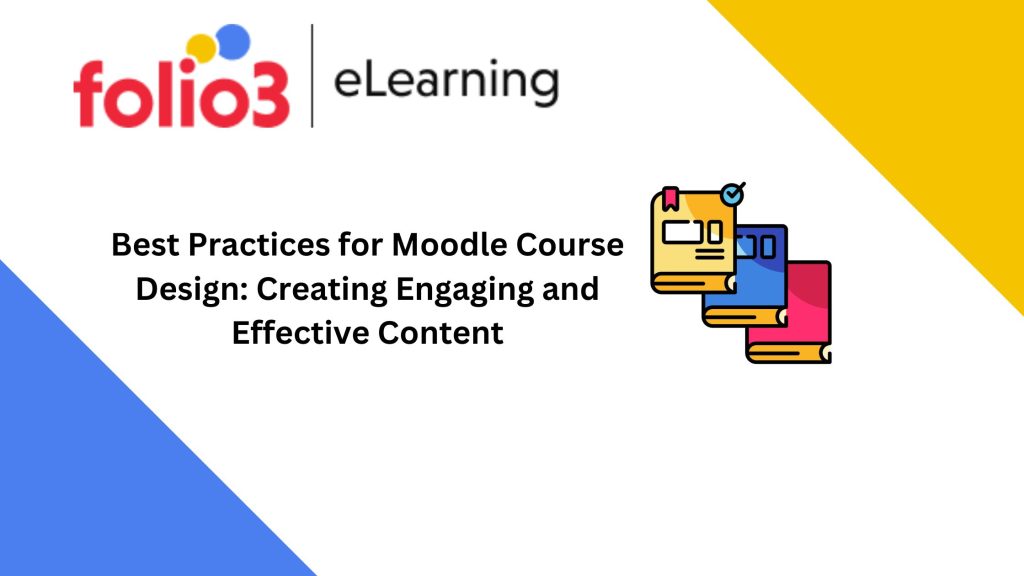
Executive Summary:
To ensure participation and efficient learning outcomes, it is essential to carefully examine a number of variables while designing a successful Moodle course. The essential best practices for Moodle course design are covered in this blog, including establishing clear objectives, giving prompt feedback, and building a collaborative learning environment.
Introduction:
Online learning is becoming common in the rapidly changing world of education, providing convenience, accessibility, and flexibility to students of all ages. Learning management systems (LMS) like Moodle have grown significantly in popularity as educators traverse the digital environment due to their extensive features and capacity to support efficient online courses. Moodle offers educators a strong platform to create and deliver dynamic, engaging lessons that increase student involvement and successful learning outcomes.
However, to create a learning experience that is genuinely immersive and effective, more than just putting course materials on Moodle is required. When creating a practical Moodle course, instructional tactics, content organization, multimedia integration, interactive activities, and learner engagement strategies must be considered. By implementing best practices in Moodle course design, instructors may make the most of the software and build lessons that engage students, deepen their comprehension, and promote active participation.
By implementing these best practices for Moodle course design, educators can unleash Moodle’s full potential as a game-changing platform for online learning. Students will be given the tools to take charge of their education, actively participate in the course material, work with their classmates, and produce worthwhile learning results. Teachers may create an online learning environment that transcends conventional boundaries, supports learner success, and equips students for the challenges of a quickly changing world by utilizing Moodle’s features and adopting smart course design.
To develop interesting, interactive, and effective online learning experiences that motivate and empower learners, let’s dive in and examine the best practices for Moodle course design.

Best Practices for Moodle Course Design:
- Establish Clear Learning Objectives:
The cornerstone of a successful course design is the establishment of clear learning objectives. Clearly state what you want your students to know and be able to do by the end of the course. The creation of instructional tactics and content is guided by learning objectives. They aid students in comprehending the course’s goal and directing their learning process. To promote clarity and concentration, ensure that learning objectives are SMART (specific, measurable, achievable, relevant, and time-bound).
- Continuous Improvement and Evaluation:
Assess the success of your Moodle course regularly, and make adjustments in response to student comments and observations. To pinpoint areas that need improvement, analyze learner engagement, assessment results, and completion rates. Collect feedback through surveys or discussion groups to learn more about the students’ experiences. Actively look for possibilities for professional development and keep up with new Moodle course design features and best practices.
- Effective Content Organization:
The foundation of a seamless learning experience is well-organized content. Use modules, topics, or units to logically and intuitively organize the course materials. Make sure the content is accessible and easily navigable. Clear headers, subheadings, and bullet points divide information into digestible portions. Use multimedia components, infographics, and interactive activities to break up text-based content’s monotony and make it more visually appealing.
- Encourage Learner Autonomy:
Encourage learner autonomy to encourage students to take charge of their own learning. Allow for pace flexibility so pupils can advance at their own learning rate. Provide further readings, supplemental materials, and self-evaluation exercises for students wanting to explore a subject. Encourage self-analysis, goal-setting, and independent study. To develop skills for lifelong learning, encourage independent thinking, problem-solving, and critical analysis.
- Encourage a Collaborative Learning Environment:
Moodle’s features encourage community among learners and collaboration. Encourage interaction and information sharing by incorporating discussion boards, group projects, peer reviews, and collaborative activities. Enhancing critical thinking, problem-solving ability, and communication skills benefit collaborative learning. The online learning environment enables students to learn from their peers, acquire new viewpoints, and develop social relationships.
- Enhance Platform Features
Moodle has various tools and features that can be customized to improve the learning experience. This is known as optimizing platform features. Examine and use tools for social learning and capabilities for tracking course completion, progress, badges, and gamification. Improve usability and accessibility by personalizing the course’s design, navigation, and user interface. Utilize elements that promote engagement in learning, self-evaluation opportunities, and a sense of accomplishment in your students.
Conclusion:
Designing a Moodle course that is both interesting and useful necessitates a thorough strategy that takes into account numerous best practices and tactics. Educators may design online learning experiences that catch students’ attention, encourage active engagement, and nurture successful learning outcomes by using the suggested practices described in this blog.
Clear learning objectives help learners understand what is expected of them and provide a roadmap for course development. Teachers promote active learning, critical thinking, and knowledge application by including interactive activities. Utilizing multimedia components improves the course’s visual appeal, accommodates different learning preferences, and encourages improved information retention.
Giving students timely and helpful feedback enables them to assess their progress, pinpoint areas for development, and develop a growth attitude. Students are encouraged to share Knowledge, critical thinking, and social connections by fostering a collaborative learning environment through discussion boards, group projects, and peer interactions.










